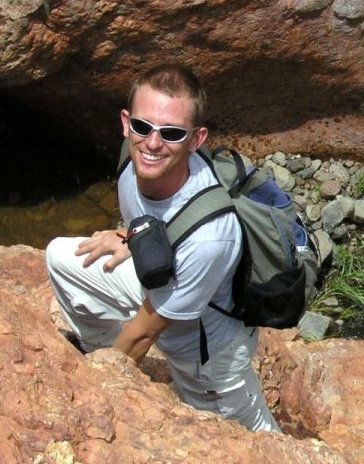I'm back from Pakistan to Tennessee for a few weeks before leaving for South Sudan on another UN contract. There's so much more to tell about Pakistan. What a complicated country! Constantly surprising. There just isn't enough time to write about it all (and you wouldn't want to read the book that would result). But I must tell you something about Shimshal, the place where Jasper, Susan, Dave and I (friends from our time in Eritrea) went trekking for three weeks in August just before leaving the country.
I know that I'm prone to superlatives, labeling this or that place as the most beautiful or most remote or most friendly. For a long time now, though, Wadi Rum, a mountain-studded desert in Jordan, has been the place I called most beautiful. But not any longer. Not too far from the true Shangri La in the mountains of Pakistan lies a place more deserving of the title. Shimshal Valley has won a few superlatives and a piece of my heart too: the most peaceful village, the most beautiful landscape, the highest place I've ever been.
Susan, Jasper, and Dave were cycling friends in Eritrea, and we had many good adventures there together. After 3 of us ended up in Pakistan working on the earthquake, we began planning a trip to go trekking in the mountains of northern Pakistan, a place that has been on my list since I was a kid and read an article in National Geographic about K2, the second highest mountain in the world that straddles the border between Pakistan and China.
Dave flew in from the UK and we started our journey from Islamabad, where I've been living since January. Normally a two day drive up the Karakoram Highway (they use the term ‘highway’ loosely), our trip took 4 days because strong monsoon rains had washed out a bridge. Eventually though, we found ourselves crammed into the back of an extended cab truck, on our way up the Shimshal Road, which was only completed in 2003. Before that, the only way to Shimshal was a strenuous 3 or 4 day walk.

This is the road, believe it or not. Most of it is a bit better than that.
Shimshal village was beautiful beyond all of our expecations. It sits perched on a bench above a raging river that drains down from a dozen glaciers further back in the mountains. The Shishalis have built small canals that divert water from high in the side canyons that come down to meet the river. This water snakes through a maze of channels to irrigate the fields where they grow potatoes, wheat, apricots, and a few vegetables. It's a communal effort, managed by committee. In general, the Shimshalis seem very community-oriented, having even organized the Shimshal Nature Trust to make decisions regarding land use management and the promotion of trekking there.
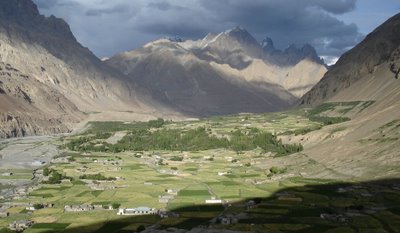
Shimshal Village sits about 10,000 ft above sea level.
The Shimshalis are part of the Ismaeli sect of Islam. They are quite moderate, with few restrictions on women and a tolerant world view. After the much more conservative Islam that you see in the rest of Pakistan, Shimshal was an incredible breath of fresh air. The people too seem quite happy and contented, which is not true in the more conservative parts of Pakistan.

Mavish and Sima led us to a stream where we could wash clothes, then stood away a bit and giggled at us.
We spent a few days based in the village, doing day hikes up to glaciers another 3,000 or 4,000 ft higher.
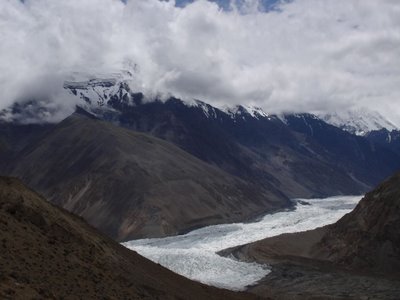
One of our acclimatization hikes took us across the Yazghil Glacier, which flows for miles out of the higher peaks and terminates near Shimshal Village. It took us about two hours to cross it.
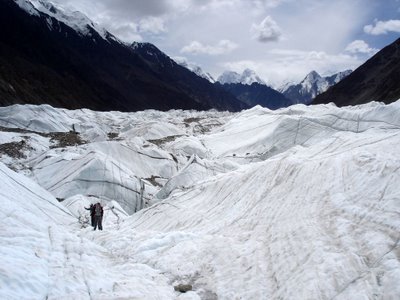
In the evenings we stayed at the little four room (but growing) hotel. Our guide, Muqueem, invited us to his house for dinner one night where we had chowpindok: flatbread layered with yak cheese and yak butter. We had this a few more times in herder’s huts that we came across on the trek. It’s tasty and filling mountain food, but I don't think I could eat it as often as the Shimshalis do.
The main event was a 10 day trek from Shimshal Village to Shimshal Pamir, the high summer pasture for the Shimshali’s yaks, goats, and sheep. The shortest route up there is a three day walk (three days for us mortals, the Shimshalis can walk it in a day if they need to), but passes through a narrow gorge about 3000 feet deep. Over generations, the Shimshalis have built and blasted a trail along the gorge walls. It’s not for anyone afraid of heights.


We traveled with our guide (no longer Muqeem, who had been called away, but one of his relatives, an experienced guide named Yahya), four porters, and two yaks. We each carried pretty full packs, but with 13 days worth of food, we couldn’t carry it all, not at these altitudes, anyway. Our porters turned out to be a delight, stopping and singing in the local Wakhi language at every significant milestone on the trail. They provided encouragement, company, and entertainment along the way.
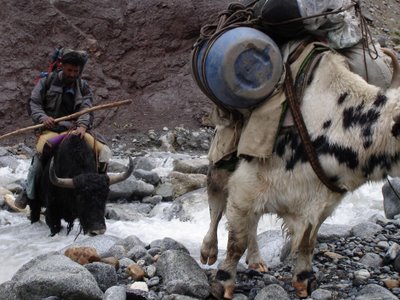
Our camps were at well-established waystations used by the Shimshalis when they travel between the village and the high pasture. The guide and porters slept in the stone huts at these places, we slept in our tents.
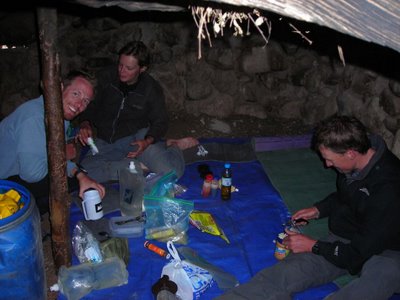
We did much of our cooking in the huts because we had rainy weather several days.
On the third day we approached our base camp and would have seen our target peak, Mungalig Sar, but clouds obscured it. At 19,850 ft, it would be the highest any of us had ever climbed.
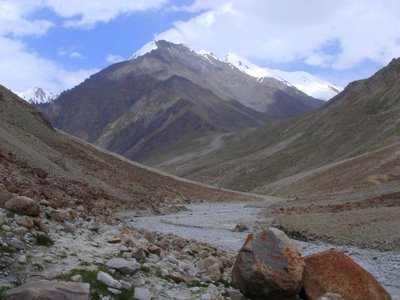
A picture of Mungalig Sar made on the return trip. It’s the white peak just to the right of center.
After a steep final climb, we finally reached the high pasture. Snowy peaks surround the green, mostly flat valley. A small river gathers the snowmelt and carries it down and back the way we came. Other Shimshalis, no more than specks on the other side of the broad valley, spot us coming over the lip and sing out, asking the news. Our porters and guide sing back that all is well, then we all dance to a song just for this place.
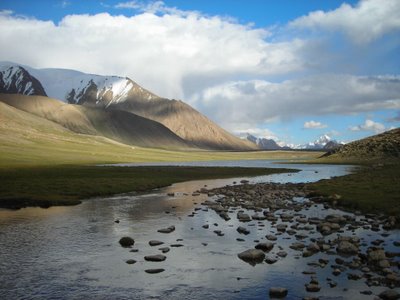
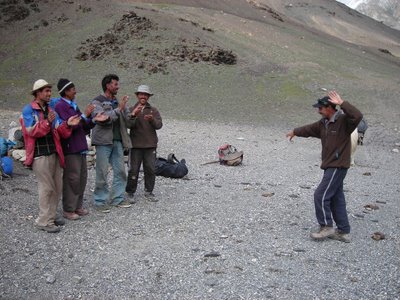
The high pasture is clearly the heart of Shimshal country. As children, the Shimshalis all come here with their mothers in the summer to tend the herds. In winter, eight men from the village are chosen to keep an eye on the yaks. The green grass, the tumbling stream, the singing herders, a horizon full of glittering peaks: it is the most beautiful place I’ve ever seen.
But my first day and night up there weren’t so good. I became ill with altitude sickness; a danger that we were well aware of, but thought we had avoided by spending so much time in Shimshal Village letting our bodies adjust to the elevation. Apparently it wasn’t enough for my body. I woke with a headache, nausea, and an unsettling apathy about being in such a beautiful place. It only got worse during the day when we walked the extra hour over to the herders' village.
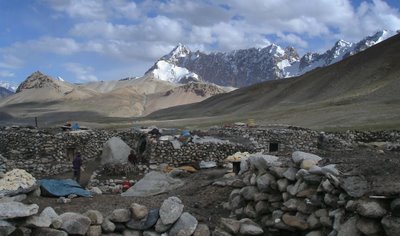
This is Shewert, the tiny village at one end of the high pasture where Shimshalis stay when they are with the herds. The white piles are cakes of yak cheese, a main staple of their diet, drying on the roofs.
Ultimately we decided that I had to go down. My symptoms were not severe, but altitude sickness only gets worse until you descend. The weather, which had been rainy, appeared to be entering a clearing phase, so the next day promised to be a good summit attempt day. While I lay curled in the corner of a hut, wanting only to sleep, my friends had to make a hard choice about whether or not to go down with me. If they followed me down, they might miss the good weather window. I woke to find they had decided to go down with me rather than split the group. Even with the apathy that came with the altitude sickness, their decision made me emotional. I felt horrible that I might cause them to miss their summit attempt, but also buoyed up by the strength of their friendship. We dropped over the other side of the pass and descended 3000 ft. I was able to walk and even carry much of my kit, but one of the porters had to carry me across a stream on his back. I just felt too weak to negotiate the rocky bottom and fast moving water.
The next morning I awoke feeling much better, and we ascended back up to the base camp. I had decided to not attempt to summit with the others the following day, but I felt so good on the way back up to the base camp that I asked our guide, Yahya, if we could bring an extra guide along with us to bring me back down if I had any problems. He agreed, so the next morning at 4:30, the four of us and two guides left our camp under stars that don't twinkle because there isn't enough atmosphere to distort their light.
Dave and Jasper found their climbing stride pretty quickly, but Susan and I were pretty slow. She had some stomach troubles that morning, and I was just suffering from the altitude. The first few hours were on small talus, small slabs of rock that tended to slide down a bit with each step, making each foot of gain that much harder. I started out counting steps, 50 or 70 slow, careful steps, then stop and rest for 10 breaths. As our altitude increased, the number of steps between rests decreased.
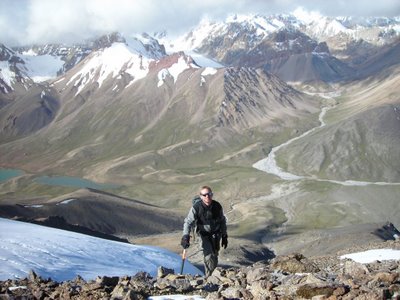
The sun finally came up and gave us some encouragement. Already the views were outstanding. Our tents were almost invisible in the huge valley far below. I had really expected frigid winds, and it was certainly around or below freezing, but with the effort of climing, the temperature was nice. Whenever we stopped for a longer rest, I had to put on my down jacket to keep from getting chilled, but I've had to do that on lower climbs.
The last 1000 feet or so of the climb was on steep snow, so we had to put on waterproof pants, crampons, and rope up. Just the effort of putting on my waterproof pants was huge. Without the encouragement of the others, there was no way I would have had the will to go further. Susan and I followed the two guides, who kicked steps in the snow for us. Dave and Jasper came behind. It was like climbing a staircase slowly, but it felt like running at full speed.
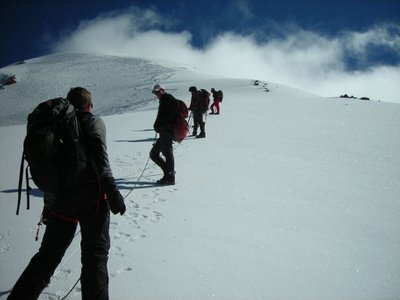
It's steeper and further than it looks. That's the summit on the left, but we're something like 1000 vertical feet (and a couple of very hard hours) below it.
The guides wanted to hurry us as much as possible because the sun was warming the snow, making the travel more difficult and avalanche more likely (there had been fresh snow about 36 hours before), but Susan and I could only go so fast. We had to stop for 10 breaths every 15 steps or so. Physically, it was the hardest thing I've ever done. We kept reminding ourselves that it doesn't have to be fun to be fun, but this was really not fun. Slowly, slowly we ascended, finally reaching the little rounded, snow covered summit six hours and 4400 feet after leaving our camp. We collapsed in hugs and congratulations. It was made all the sweeter because we had all made it together, even though it had so often looked like one or the other of us (usually me) wouldn't make the climb. Impossibly, from the valley below we heard the faintest wisps of singing, the herders below could see that we had reached the summit. Our guides responded by singing the "all is well" song.


The views from the top were outstanding. No photo could ever capture the grandeur of the endless sea of peaks and glaciers that surrounded us. Several higher peaks were visible in the distance, but K2, second only to Everest, was obscured by clouds.
The descent was punishing, and seemed to take longer than the climb, though it didn't. Finally reaching camp in the early afternoon, we found our porters waiting for us, with garlands of meadow flowers to celebrate our successful climb. Tired beyond all memory, I took a nap in the sun, which I think was my favorite part of the whole trip, though a curious yak kept waking me up snuffling at my feet and our gear.
Over the next four days, we made our way back to Shimshal on a different route that took us up over the 17,400 ft. Shpodeen Pass. Already tired from 9 days on the trail, and with full packs, the pass was exhausting. I had to let Yahya carry my pack the last hour or so to get over it. But it was all downhill from there, including a beautiful walk through Zardgarben, a beautiful meadow surrounded by rocky peaks. One of our porter's sons was traveling back with us. Eight-year-old Mullah Korban walked every step of the way, including the pass where I couldn't even carry my pack. These Shimshalis are made of very tough stuff.

Zardgarben
As we arrived back in Shimshal the next day, we passed a beautiful little stone walled apricot orchard and the owner invited us in. He shook a branch and the sun-warmed apricots fell to the ground for a feast. After so many days of the pasta and oatmeal we brought for the trip, fresh fruit was a delight. It captured perfectly the richness of life in Shimshal and the hospitality of its people.
